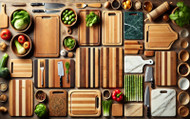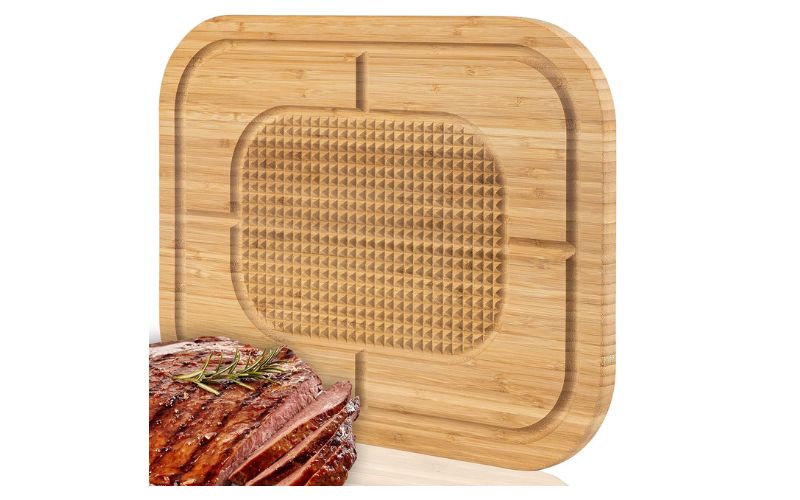Top 5 Types of Cutting Boards for Every Kitchen
Sep 11, 2024

When choosing a cutting board, weighing your options carefully based on your kitchen habits and preferences is essential. Wood cutting boards, such as maple or cherry, offer durability and natural antibacterial properties. If sustainability matters to you, bamboo cutting boards are eco-friendly, combining lightness with strength. Rubber boards provide a durable, knife-friendly surface, while plastic ones are budget-friendly and easy to clean, though they can warp. Glass boards, although stylish, might dull your knives. Which option truly fits your kitchen needs? Let’s explore the pros and cons of each type in more detail.
Upgrade your kitchen with our eco-friendly, durable Bamboo Cutting Board. Shop now for the perfect blend of style and sustainability!

Wood Cutting Boards
When selecting a cutting board, consider wood options like maple, oak, and cherry for their durability and knife-friendliness. Wooden boards, especially those made from maple wood, are renowned for their durability and natural antibacterial properties.
- End-grain wood cutting boards are particularly knife-friendly because they allow the knife to sink into the grain, preserving the blade’s edge. This type is also more durable, absorbing cuts and reducing wear and tear.
- While not technically wood, bamboo cutting boards offer a sustainable and lightweight alternative. They’re eco-friendly but harder on knives than traditional wooden boards.
- Composite cutting boards, such as those produced by Epicurean, combine wood fibers and resin to create a durable, knife-friendly surface that’s dishwasher-safe. They offer a practical blend of wood’s benefits and modern convenience.
- However, wooden boards do require more maintenance. You’ll need to oil them to prevent drying and cracking periodically. This extra care pays off with longevity and consistent performance. Maple, oak, and cherry boards aren’t just functional—they’re also naturally antibacterial, reducing the risk of contamination.
Plastic Cutting Boards
Plastic cutting boards offer a lightweight and budget-friendly option for home cooks. They are also cheaper than their wood or rubber counterparts and boast several practical advantages.
- One of the most appealing features of plastic cutting boards is that they’re easy to sanitize. Since they’re less absorbent, you can toss them in the dishwasher without worrying about damage, making them an excellent option for those who prioritize hygiene.
- However, plastic cutting boards do have a few downsides. Over time, they’re prone to warping and scuffing, making them less durable than wood or rubber boards. Despite this, their low cost and ease of maintenance make them a popular choice for many kitchens.
- Another benefit of plastic cutting boards is their availability in various colors and sizes. This feature allows you to implement color-coding in your kitchen, helping to prevent cross-contamination by assigning different colors to specific tasks, such as cutting meat, vegetables, or bread.
Bamboo Cutting Boards
If you’re looking for a more sustainable and durable option, bamboo cutting boards offer a range of benefits that make them stand out. These cutting boards are lightweight yet sturdy, making them incredibly easy to handle during food prep.
- You’ll appreciate the eco-friendly nature of bamboo cutting boards. Bamboo is a sustainable material that grows rapidly, reducing environmental impact.
- One key advantage of bamboo cutting boards is their resistance to knife marks. Unlike other materials, bamboo maintains a smoother surface, which looks better and extends the board’s lifespan.
- Additionally, these boards resist water absorption, reducing the likelihood of warping or cracking over time.
- Another significant benefit is that bamboo cutting boards are naturally antimicrobial. This means they inhibit bacteria growth and help prevent odors, making your kitchen more hygienic.
Read More: Kitchen Rack Over Sink: Types & Installation Tips
Rubber Cutting Boards
Rubber cutting boards offer a durable, knife-friendly surface perfect for everyday kitchen tasks. These boards are incredibly durable and softer than wood, making them an excellent choice for preserving the sharpness of your knives. Because they don’t require mineral oil for maintenance, they offer low upkeep, saving time and effort in your kitchen routine.
- While rubber cutting boards aren’t dishwasher-safe, a simple hand wash with soap and water will suffice. However, they can be heavier and pricier than plastic options, so you’ll need to weigh the benefits against the cost and convenience.
- The heavier construction adds to their stability, ensuring they stay put on your countertop during use.
- Despite the higher cost, rubber cutting boards' reliability and knife-friendly surface make them a valuable investment for your kitchen. If you’re looking for a cutting board that’s both durable and gentle on your knives, opting for a rubber cutting board could be the ideal solution for your culinary needs. Their low upkeep and long-lasting nature make them a practical choice for anyone serious about their kitchen tools.
Glass Cutting Boards
While rubber cutting boards offer durability and knife-friendliness, glass cutting boards present a stark contrast with their brittle nature and tendency to dull knives quickly.
- Glass cutting boards are known for their fragility, which makes them prone to breakage and a potential safety hazard in the kitchen. When you’re slicing and dicing, the hard surface of a glass board can rapidly dull your knives, making it far from knife-friendly.
- Because of these drawbacks, glass cutting boards have limited practical use and aren’t recommended for most cutting tasks. Unlike wood or plastic boards, they don’t absorb liquids, which might seem beneficial, but this feature doesn’t outweigh the downsides. The non-absorbent surface can lead to food slipping around, increasing the risk of accidents.
Professional chefs and cooking enthusiasts typically avoid glass cutting boards. Their fragility and tendency to dull knives make them unpopular in any serious kitchen. If you’re considering a cutting board, it’s wise to look elsewhere. Opt for materials that provide better durability and knife-friendliness, ensuring a safer and more efficient cooking experience.
Conclusion
When choosing a cutting board, consider what matters most to you. Wood boards, like maple and oak, offer durability and natural antibacterial properties. Bamboo is sustainable and sturdy, while rubber is knife-friendly and long-lasting. Plastic boards are affordable and easy to sanitize, though they might warp. Avoid glass boards, as they can dull your knives and break easily. With these options, you’ll find the perfect cutting board to fit your needs and preferences.
